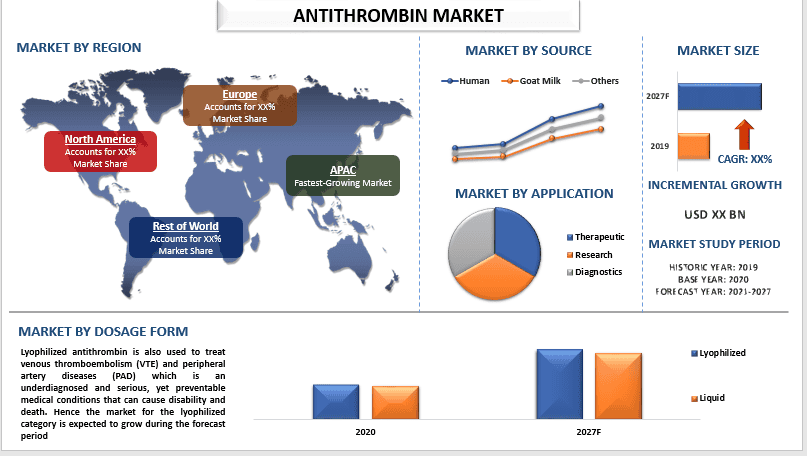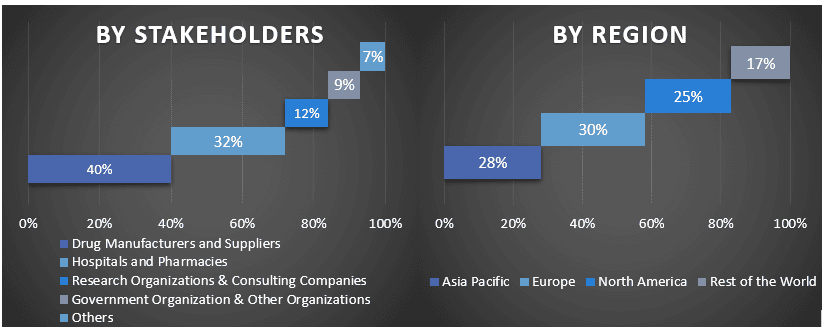
预计抗凝血酶市场在预测期内(2021-2027年)将以约5%的复合年增长率增长。抗凝血酶是由肝脏产生的一种小糖蛋白,通过中和凝血酶的酶活性,使凝血系统的许多酶失活。抗凝血酶缺乏会导致血栓栓塞,这是一种在血管中形成血块的疾病,会严重影响肾脏、大脑、胃肠道和肺等其他器官的功能。此外,这会在手术期间和手术后以及怀孕期间造成并发症,未经治疗的抗凝血酶缺乏症与高达50%的静脉血栓栓塞(VTE)风险和2.1的妊娠丢失相对风险以及5倍的死产增加相关。此外,根据疾病控制和预防中心(CDC)的数据,2020年美国共登记了3,613,647名新生儿。
抗凝血酶市场的主要运营公司包括F Grifols S.A.、Octapharma AG、LFB USA Inc.、CSL Limited、武田制药、Axis-Shield Plc、西门子股份公司、赛默飞世尔科技、Lee Biosolutions Inc.、BDI Pharma Inc.
报告中提出的见解
“在应用中,治疗类别在2020年占据了市场的大部分份额”
根据应用,抗凝血酶市场分为治疗、研究和诊断。预计治疗类别在预测期内将见证可观的增长率。这主要是由于血栓疾病的日益流行以及抗凝血酶在治疗和诊断中的使用增加。此外,由于血栓形成导致的心力衰竭、高血压和冠状动脉疾病等心脏疾病的病例增加,也促进了市场的增长。例如,根据美国血液学协会发布的数据,美国每年有90万人发生血栓,每年约有10万人因此丧生。
“在来源中,预计山羊奶类别在预测期内将见证最高的复合年增长率”
根据来源,抗凝血酶市场分为人源、山羊奶和其他。预计山羊奶类别在预测期内将见证显著的增长率。由于其生产抗凝血酶蛋白的高能力,F.D.A.也批准了用于制造该药物的山羊,这是该机构根据指导方针批准的首批监管转基因动物在美国药物和食品供应中的使用。此外,抗凝血酶III缺乏症是一种血栓疾病,是深静脉血栓形成(DVT)和肺栓塞(PE)的主要原因。例如,根据美国国家生物技术信息中心(NCBI)的数据,肺栓塞(PE)的年发病率范围为每10万人39至115人;对于深静脉血栓形成(DVT),发病率范围为每10万人53至162人。
“在剂型中,预计冻干类别在预测期内将见证可观的增长率”
根据剂型,抗凝血酶市场分为冻干和液体。冻干类别占据了市场的重要份额,预计在预测期内将见证可观的增长率。这主要是由于其在治疗凝血酶缺乏症和冠心病(CAD)中的广泛应用。此外,冻干抗凝血酶也用于治疗静脉血栓栓塞(VTE)和外周动脉疾病(PAD),这是一种未被充分诊断且严重的,但可预防的疾病,可能导致残疾和死亡。
“预计北美在预测期内将见证显著增长”
为了更好地了解市场,该报告详细分析了主要地区和国家,包括北美(美国、加拿大、北美其他地区);欧洲(德国、英国、法国、西班牙、意大利、欧洲其他地区);亚太地区(中国、印度、日本、澳大利亚、韩国、亚太其他地区)和世界其他地区。北美在预测期内占据了重要的市场份额。这主要是由于外周动脉疾病(PAD)、心脏相关疾病肥胖、AT缺乏症等抗凝血酶缺乏症的流行。此外,主要制药和药品制造公司的存在以及完善的医疗保健基础设施也促进了该市场的增长。例如,根据美国卫生与公共服务部发布的数据,预计全球每2000人中约有1人患有抗凝血酶缺乏症。
购买本报告的理由:
- 该研究包括经过认证的主要行业专家验证的市场规模和预测分析。
- 该报告一目了然地快速回顾了整个行业绩效。
- 该报告深入分析了杰出的行业同行,主要关注关键业务财务、产品组合、扩张策略和最新发展。
- 详细考察行业中存在的驱动因素、限制因素、关键趋势和机遇。
- 该研究全面涵盖了跨不同细分市场的市场。
- 对行业进行深入的区域层面分析。
定制选项:
抗凝血酶市场可以根据要求或任何其他细分市场进一步定制。此外,UMI理解您可能拥有自己的业务需求,因此请随时与我们联系以获取完全符合您要求的报告。
目录
抗凝血酶市场分析的研究方法 (2021-2027)
分析历史市场、评估当前市场以及预测抗凝血酶市场的未来市场是创建和分析全球主要地区抗凝血酶市场应用情况的三个主要步骤。进行了详尽的二级研究,以收集历史市场数据并评估当前市场规模。其次,为了验证这些见解,我们考虑了许多发现和假设。此外,还与抗凝血酶市场价值链上的行业专家进行了广泛的初步访谈。在通过初步访谈对市场数据进行假设和验证后,我们采用了自上而下/自下而上的方法来预测完整的市场规模。此后,采用市场细分和数据三角测量方法来评估和分析行业相关细分市场和子细分市场的市场规模。详细的方法如下所述:
历史市场规模分析
第 1 步:深入研究二级来源:
我们进行了详细的二级研究,通过公司内部来源(如年度报告和财务报表、业绩演示文稿、新闻稿等)以及外部来源(包括期刊、新闻和文章、政府出版物、竞争对手出版物、行业报告、第三方数据库和其他可靠的出版物),获取抗凝血酶市场的历史市场规模。
第 2 步:市场细分:
在获得抗凝血酶市场的历史市场规模后,我们进行了详细的二级分析,以收集历史市场见解,并分享主要地区不同细分市场和子细分市场的数据。报告中包含的主要细分市场有应用、来源和剂型。此外,还进行了国家层面的分析,以评估该地区检测模型的总体采用情况。
第 3 步:因素分析:
在获得不同细分市场和子细分市场的历史市场规模后,我们进行了详细的因素分析,以评估抗凝血酶市场的当前市场规模。此外,我们使用自变量和因变量(如抗凝血酶市场的各种应用、来源和剂型)进行了因素分析。我们对需求和供应侧情景进行了透彻的分析,考虑了全球抗凝血酶市场领域的顶级合作、兼并和收购以及业务扩张。
当前市场规模估算与预测
当前市场规模:根据上述 3 个步骤的可操作见解,我们得出了抗凝血酶市场的当前市场规模、主要参与者以及细分市场的市场份额。所有必需的百分比份额拆分和市场细分都是使用上述二级方法确定的,并通过初步访谈进行了验证。
估算与预测:对于市场估算和预测,我们为不同的因素分配了权重,包括驱动因素和趋势、制约因素以及利益相关者可获得的机会。在分析了这些因素后,我们应用了相关的预测技术,即自上而下/自下而上的方法,以得出 2027 年全球主要市场不同细分市场和子细分市场的市场预测。用于评估市场规模的研究方法包括:
- 该行业的市场规模,以收入(美元)以及抗凝血酶市场在国内主要市场的采用率衡量
- 市场细分市场和子细分市场的所有百分比份额、拆分和细分
- 抗凝血酶市场中按所提供解决方案划分的关键参与者。此外,这些参与者为在快速增长的市场中竞争而采取的增长策略
市场规模和份额验证
初步研究:与关键意见领袖 (KOL) 进行了深入访谈,包括主要地区的高层管理人员(CXO/VP、销售主管、营销主管、运营主管、区域主管、国家主管等)。然后总结了初步研究结果,并进行了统计分析以证明所述假设。初步研究的输入与二级研究结果相结合,从而将信息转化为可操作的见解。
不同地区初步参与者的划分

市场工程
采用数据三角测量技术来完成整体市场评估,并得出抗凝血酶市场每个细分市场和子细分市场的精确统计数据。在研究了抗凝血酶市场应用、来源和剂型领域的各种参数和趋势后,将数据分为几个细分市场和子细分市场。
抗凝血酶市场研究的主要目标
研究中指出了抗凝血酶市场的当前和未来市场趋势。投资者可以获得战略见解,从而根据研究中进行的定性和定量分析来判断其投资。当前和未来市场趋势决定了区域层面市场的整体吸引力,为行业参与者提供了一个利用未开发市场以从先行者优势中获益的平台。研究的其他定量目标包括:
- 分析抗凝血酶市场当前和预测的市场规模(按价值(美元)计算)。此外,分析不同细分市场和子细分市场的当前和预测的市场规模
- 研究中的细分市场包括应用、来源和剂型领域。
- 定义和分析抗凝血酶市场行业的监管框架。
- 分析涉及各种中介机构的价值链,同时分析行业的客户和竞争对手行为。
- 分析主要地区抗凝血酶市场当前和预测的市场规模。
- 报告中研究的主要地区和国家包括北美(美国、加拿大、北美其他地区);欧洲(德国、英国、法国、西班牙、意大利、欧洲其他地区);亚太地区(中国、印度、日本、澳大利亚、韩国、亚太地区其他地区)和世界其他地区。
- 抗凝血酶市场的公司简介以及市场参与者为在快速增长的市场中维持增长而采取的增长策略
- 深入分析行业的区域层面
相关 报告
购买此商品的客户也购买了










